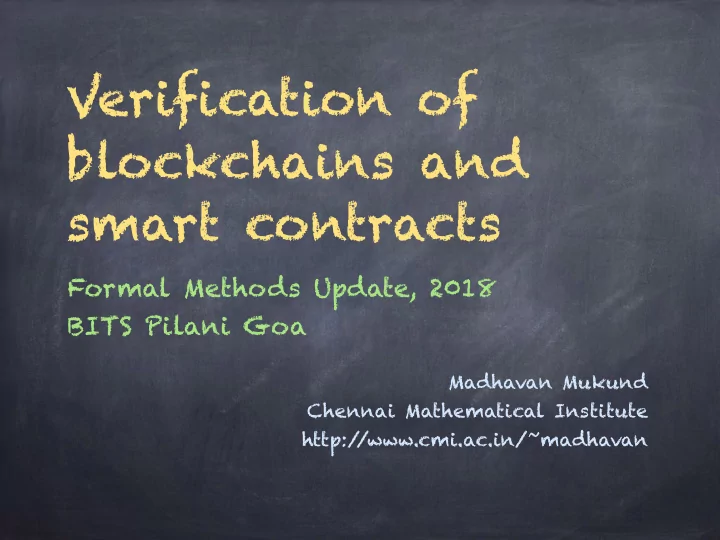

Verification of blockchains and smart contracts Formal Methods Update, 2018 BITS Pilani Goa Madhavan Mukund Chennai Mathematical Institute http:/ /www.cmi.ac.in/~madhavan
Outline Introduction to blockchains Smart contracts Verification issues
Introduction to blockchains
Banks and ledgers Record of all transactions Maintained by a trusted authority Each entry is validated Compute net balance etc
Public ledgers Ledgers are private Can we maintain a public ledger? Eliminate trusted authority
Challenges Integrity of individual transactions Consensus on overall set of transactions
A solution Maintain a distributed ledger Duplication prevents tampering Cryptography for authentication
A solution A physical ledger has pages Distributed version has blocks of data These blocks are linked together Blockchain!
Blocks Each block is a collection of transactions Each block points to parent block
Hash function Compute random The quick brown summary of input fox jumps over the lazy dog. “Impossible” to invert Collisions rare Different inputs 0d7006cd055e94cf produce 614587e1d2ae0c8e different outputs
Blockchain integrity parent hash(parent) Each block has a hash(my hash of the transactions) transactions it Transactions contains Each block parent includes a hash hash(parent) hash(my of parent block transactions) Transactions
Public key cryptography Each person P has The quick brown a pUblic key U and fox jumps over the lazy dog. a pRivate key R U U and R are 0d7006cd055e94cf inverses 614587e1d2ae0c8e To encrypt text t R for P to read, The quick brown send U(t) fox jumps over R(U(t)) = t the lazy dog.
Digital signatures U and R are Madhavan Mukund inverses R R(U(t)) = t Also, 0d7006cd055e94cf U(R(t)) = t !! 614587e1d2ae0c8e Sign using R U Recipient can Madhavan Mukund verify using U
Transactions Who writes the transactions in the blockchain? Transaction No centralised From A authority To B Transactions are Amount created by originator
Transactions A digitally signs Cannot repudiate later Transaction From A A uses B’ s public Dig Sig of A key to create a To B challenge only B Challenge can solve Amount Only B can claim this amount
Transactions Where’ s the money? Transaction No centralised From A authority to certify Dig Sig of A the money A holds To B Must refer to Challenge previous Amount transactions where Sources of A acquired the funds money
Adding blocks Peer to peer network Transactions broadcast to all nodes Periodically, collect transactions into a block and add to chain
Mining blocks Process of adding a block is called mining Mining is decentralised Blockchain may fork Integrity of the ledger is lost!
Distributed consensus All nodes should agree on blocks Elegant solution due to Satoshi Nakomoto Emerging distributed consensus
Proof of work Adding a node requires solving a hashing problem Brute force search Calibrated so that it takes about 10 minutes to solve on current hardware
Proof of work After mining a block, miner broadcasts Other miners abandon efforts, accept this block, move to next block Serial numbers
Blockchain forking Two miners may succeed in parallel Variants of chain may propagate Mismatch between your chain and new block — keep longer chain Eventually converges
Incentive for mining Why spend computational effort to mine? Transaction fees and other incentives Bitcoin!
Smart contracts
Transactions A uses B’ s public key to create a Transaction challenge only B From A can solve Dig Sig of A To B Only B can claim Challenge this amount Amount How is this done?
Challenge scripts Simple stack based programming language Locking script DUP HASH160 <PubKHash> EQUALVERIFY CHECKSIG <PubKHash> — hash of B’ s public key Unlocking script <Sig> <PubK> <Sig> <PubK> — signature, public key of B
Challenge scripts … Concatenate and execute on stack VM <Sig> <PubK> DUP HASH160 <PubKHash> EQUALVERIFY CHECKSIG
More general scripts Multisignature N public keys recorded in the script M must provide signatures to unlock Conditional Three partners, majority must sign Lawyer can access with one partner
Scripting language Bitcoin Scripting language is intentionally Turing incomplete Conditionals, but no loops Ethereum Richer language, Turing complete High level language Solidity that compiles down to stack language
Smart contracts A script that executes when a transaction is invoked Ethereum contracts can express objects with encapsulated state Example: DAO Decentralized Autonomous Organisation
Verification
Blockchain convergence Proof of work — eventually convergent solution to distributed consensus Ensures blockchain does not fork Need majority collusion to fabricate alternate chain Would allow double spending
Vulnerability Hijacking Bitcoin: routing attacks on cryptocurrencies, Apostolaki et al, IEEE Security and Privacy 2017 Structure of Internet is not uniform Concentration of switches, routers make partitioning possible Can also delay packets
Model checking Modeling and Verification of the Bitcoin Protocol, Chaudhury et al, MARS Workshop 2015 UPPAAl model of Bitcoin network Investigate forking, double spending Model checking of a very small scale model, 4 nodes, 1 malicious
Smart contract verification Online Detection of Effectively Callback Free Objects with Applications to Smart Contracts, Grossman et al, POPL 2018 Decentralized Autonomous Organisation DAO bug stole $150 million dollars Reentrant code (callbacks) Automatic verification of effectively callback free objects
DAO Object Dao Map <Object,int> credit int balance Invariant (sum o: credit[o]) = balance Method Method withdrawAll(Object o) deposit(Object o, int amount) if (credit[o] > 0) this.balance -= credit[o] += amount credit[o] balance += amount o.pay(credit[o]) credit[o] = 0
DAO attack Method Object Attacker withdrawAll(Object o) Object Dao if (credit[o] > 0) bool stop = false this.balance -= int balance credit[o] o.pay(credit[o]) Method pay(int profit) credit[o] = 0 this.balance += profit Method if (!stop) deposit(Object o, int amount) stop = true Dao. credit[o] += amount withdrawAll(this) balance += amount stop = false
Recommend
More recommend